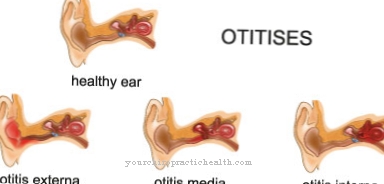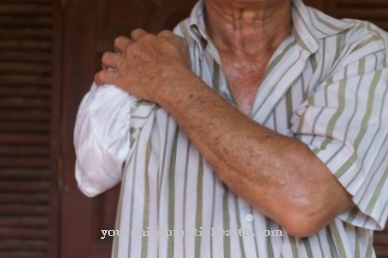Inflammatory processes or adverse health effects in the airways contribute to the fact that those affected often feel very limited in their sense of wellbeing and their performance. A Inflammation of the trachea or. Tracheitis is rare, but requires medical treatment to limit further damage to health.
What is trachitis?

© vecton - stock.adobe.com
The Inflammation of the trachea is in professional circles and also among medical laypeople as Tracheitis known, whereby the ending -itis always describes an inflammatory process.
The trachitis is primarily localized in the upper area of the airways and is perceived as extremely unpleasant. As a rule, several sections of the upper windpipe are affected prior to the trachitis. In trachitis, these are both the windpipe itself and the larynx and bronchi.
These organs are very close together, so that the inflammatory phenomena and the causative pathogens can quickly spread from one organ to the other. Under these circumstances, there is also the need to carry out a differentiated and as precise as possible diagnosis of an inflammation of the trachea.
causes
The making of a Inflammation of the trachea as well as their extent depend on very varying influencing factors, which result from both the environment and the internal constitution in relation to the patient's defenses.
It is typical of an inflammation of the trachea that, with regard to temporal relationships, there are indications which are linked to an infection caused by viruses. If an infection of the upper respiratory tract has survived, for example after a flu, then the symptoms are often prolonged by an inflammation of the trachea. The pathogenic microorganisms, which primarily include bacteria, viruses or even fungi, migrate from the nasopharynx down to the larynx and spread throughout the entire windpipe.
In addition to microbial pathogens, corrosive gaseous substances can also be used for the inflammation of the trachea, which penetrate the windpipe through the natural inhalation process.
Symptoms, ailments & signs
An inflammation of the windpipe can cause a variety of symptoms and ailments. Hoarseness and coughing as well as a burning sensation under the breastbone are typical of the disease. The cough starts out as a dry cough with little or no mucus secreted. This makes it very stressful for those affected.
The initial hoarseness can lead to a complete loss of voice. Usually there is also a burning pain under the breastbone, which gets worse as the disease progresses. At the same time, general flu symptoms such as tiredness, fever and body aches occur. Sick people are physically and mentally exhausted and can only cope with everyday tasks with great effort.
The exhaustion increases in the first days of the illness, but goes back after one to two weeks. Children may experience shortness of breath and loud breathing noises due to their narrow airways. There is also an increased risk of bacterial superinfection, which manifests itself in breathing difficulties and typical signs of inflammation.
If the trachitis is dragged on, it can develop into a chronic disease. This leads to recurring dry coughs, sore throats and increasing malaise. In the long term, chronic tracheitis can change the color of the voice.
Diagnosis & course
As a rule, they already apply to one Inflammation of the trachea occurring symptoms as an aid for a diagnosis. Classic symptoms of an inflammation of the trachea are a hoarse voice as well as more or less severe impairment of the sound formation, permanent coughing and coughing, tightness behind the breastbone and fever, pain in the limbs, fatigue and sometimes even breathing difficulties (often in children).
The doctor also hears unusual noises with the stethoscope that occur when breathing during the inflammation of the trachea. This anomaly is particularly evident when you exhale. In contrast to acute windpipe inflammation that subsides after a few days, chronic, persistent windpipe inflammation lasts for more than three weeks and can develop into bronchitis.
Complications
In the worst case, an inflammation of the windpipe can be fatal if it is not treated promptly by a doctor. The reduced supply of oxygen can severely damage the internal organs and the brain, resulting in irreversible consequential damage that is ultimately no longer treated. Those affected themselves suffer from coughing and hoarseness.
Furthermore, there is a reactive high fever and fatigue and tiredness of the patient. The resilience decreases significantly and there are complaints and symptoms that are very similar to flu. Furthermore, the patient's larynx can become inflamed and lead to death. It is not uncommon for headaches and body aches to occur and those affected suffer from a general feeling of illness.
The patient's quality of life is considerably reduced and restricted by the inflammation of the trachea. Treatment of trachitis can take place with the help of drugs and antibiotics. However, there are also many means of self-help available to those affected to treat this inflammation and alleviate the symptoms.
There are no particular complications and the disease usually progresses positively. The life expectancy of the patient is also not affected by this inflammation if it is treated in good time.
When should you go to the doctor?
If the hoarseness or cough persists, a doctor should be consulted for control. Complaints that persist for several days or are of an increasing nature should be examined and treated with medication. A doctor is required if the vocalization is reduced or the voice is lost. Pain or scratchy throat, discomfort in the throat, or dry mouth should be checked by a doctor. If the usual level of performance drops or if you experience flu-like symptoms, a visit to a doctor is advisable. Tiredness, fever or a general feeling of illness indicate an existing health irregularity that should be clarified by a doctor.
If there is no medical care, the patient is threatened with chronic disease. It can lead to permanent damage to the vocal system, which should be prevented. Difficulty breathing and fatigue are other signs of illness that should be assessed by a doctor. A refusal to eat due to an existing sore throat must also be examined by a doctor. If the person concerned suffers from discomfort of the sternum, dry sputum or shortness of breath, it is advisable to see a doctor. If psychological complaints such as anxiety, mood swings or behavioral problems arise, it is also advisable to consult a doctor.
Treatment & Therapy
To a Inflammation of the trachea To treat them as quickly and gently as possible, there are various measures available to doctors. In addition, there are also extremely effective applications that can be used as an alternative to traditional home remedies.
In addition to avoiding inhalation of gases that irritate the mucous membranes, inhaling liquids made up of table salt helps against an inflammation of the trachea. It is also beneficial to use natural cough suppressants or teas with chamomile, linden blossom and sage or hot milk with a teaspoon of honey against the excruciating irritating cough that occurs with an inflammation of the trachea. Lozenges or candies with anti-inflammatory herbs and eucalyptus keep your mouth moist and clear the airways.
Since an inflammation of the trachea can under certain circumstances promote pneumonia, especially in children and elderly people, their therapy sometimes requires the use of efficient antibiotics as well as drugs that loosen the mucus.
You can find your medication here
➔ Medicines against coughs and coldsOutlook & forecast
The prognosis is usually favorable. The trachitis heals on its own within a week. If the typical symptoms persist afterwards, it is necessary to consult a doctor. Then there is a suspicion that bacterial cultures are causing the symptoms. Doctors prescribe antibiotics. If the drug therapy shows no effect, there are other causes. These must be clarified in detail.
Children and the elderly are primarily at risk. But people with a weakened immune system are also considered to be relatively susceptible to trachitis. Their reduced defense systems allow the inflammation to spread. Serious pneumonia is the result in rare cases. This has made the overall situation worse.
If the windpipe occurs in the context of a cold or flu, a vitamin-rich diet ensures a faster healing process. Smokers should temporarily stop their nicotine consumption out of self-interest.
An inflammation of the trachea can also develop chronically. Then irritants are the trigger. It is not uncommon for constrictions and obstructions in the windpipe to develop over the years. In these cases, the prognosis turns out to be significantly worse. There is a lack of stability, which can lead to life-threatening consequences.
prevention
A prevention against a Inflammation of the trachea can definitely be realized if the immune system is strengthened (balanced diet rich in vitamins, exercise in the fresh air). For smokers, it is important to refrain from tobacco consumption if there are signs of an inflammation of the trachea.
Humidifying dry room air is also beneficial in order to avoid inflammation of the trachea. Dry air irritates the mucous membranes and dries them out. This allows the germs to pass through the areas better and cause an inflammation of the trachea.
Upper respiratory tract infections are also caused by aggressive vapors that may be in the air. This environment should therefore be avoided or protective equipment should be worn. Rapid, targeted treatment of influenza-like effects is also considered a sensible prophylaxis against trachitis.
Aftercare
Regular follow-up examinations are essential if you have an inflammation of the trachea. Depending on the severity of the symptoms, an individual therapy plan is set up to help reduce the symptoms in the long term. Long-term medications are also of great importance here and must be taken regularly.
If the patient has been symptom-free for years, he can slowly stop the medication to see how this affects the course of the disease. Under certain circumstances he can even do without them completely. Since an inflammation of the trachea is accompanied by flu-like symptoms that put an acute strain on the body, the resumption of everyday life should be done carefully. This also includes gradually increasing the usual exercise program in order to avoid a relapse.
You can do that yourself
In the event of an inflammation of the trachea, the doctor should definitely be consulted. Medical therapy can be supported by some self-help measures and home remedies.
First and foremost, the windpipe must be spared - lots of sleep and relaxation are indicated. The inflammation heals the fastest if the bedroom is ventilated regularly. After the acute phase of illness, recovery can be supported by exercise, although warm clothing and a scarf should of course be worn. The urge to cough can be relieved with sage, lime blossom, honey and other natural remedies. Anti-inflammatory herbs such as lady's mantle or ginger as well as lozenges with eucalyptus help with inflammation. Regular inhalation helps against dry airways and coughs. Saline solutions or tea, which are best prepared with an electric vaporizer, are particularly effective.
Fever is best treated with cool compresses and an appropriate diet. In the case of hoarseness or loss of voice, warm milk with honey also helps in addition to rest. An effective alternative from homeopathy is the globules aconite in potency D12. If the complaints do not decrease despite all measures, medical advice is required.


.jpg)
























